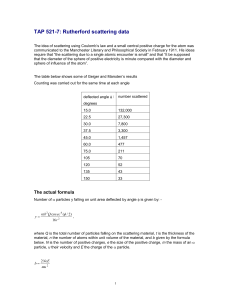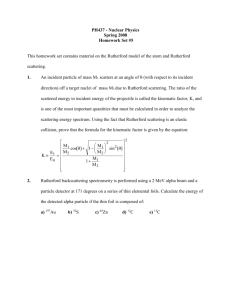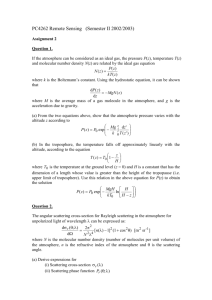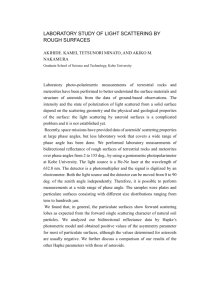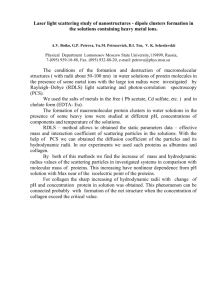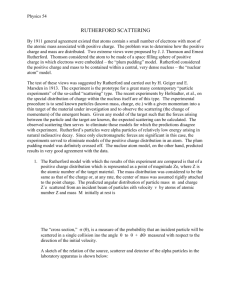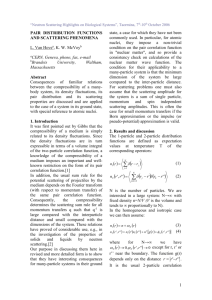Lab Report - Year 2 Term 1.2 - Study of Alpha Particle Scattering
advertisement
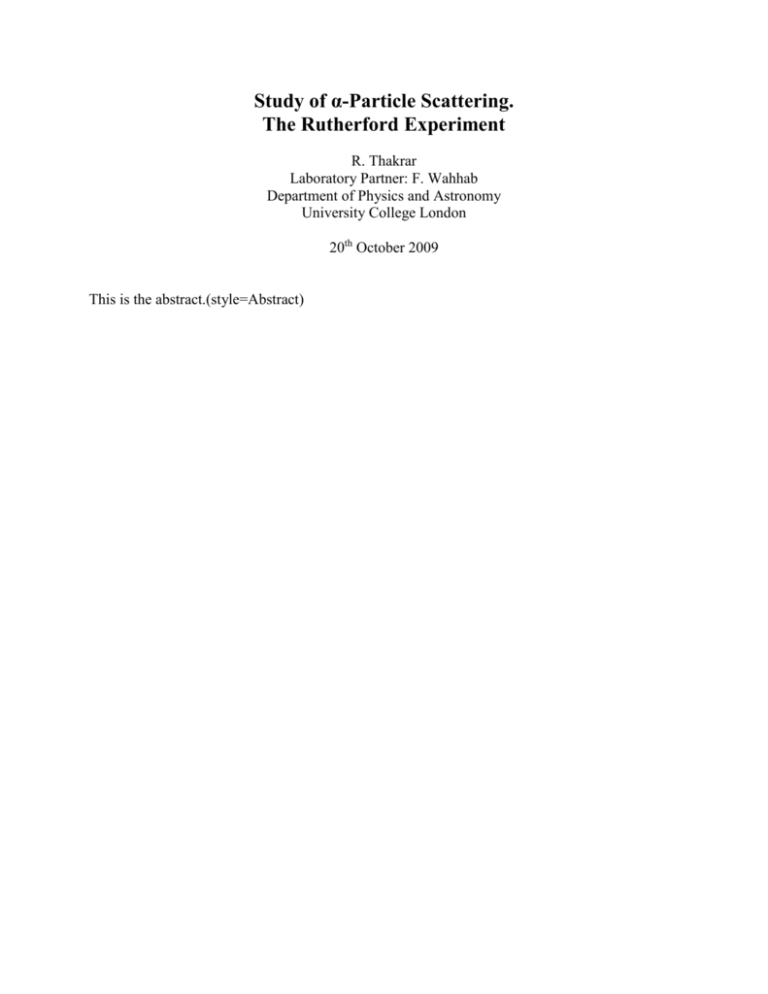
Study of α-Particle Scattering. The Rutherford Experiment R. Thakrar Laboratory Partner: F. Wahhab Department of Physics and Astronomy University College London 20th October 2009 This is the abstract.(style=Abstract) 1. Introduction This experiment aimed to achieve the same results as the Rutherford scattering experiment. This experiment was originally conducted by Ernest Rutherford in 1909 by investigating the angular dependence of α-particle scattering from a gold leaf. The experiment will be used to verify that the α-particle scattering takes place from a dense nucleus of positive charge, as Rutherford had realised previously.1 α-particles are known now to be Helium nuclei, consisting of two protons and two neutrons.2 The experiment is classically considered as a Coulomb Scattering between a massive nucleus and an incident particle, considered to be both positive and point charges. Scattering of these α-particles takes place on gold leaf – a piece of gold foil thin enough so that scattering of α-particles from multiple gold nuclei can be ignored. As the gold particles are heavy, the fraction of an incident parallel beam of intensity, I, scattered at an angle ϕ into a detector normal to an area dS, at distance R from the scattering centre, is governed by Equation (1) below. Nt = number of atoms per unit volume in the scattering foil (m-3) t = thickness of foil (m) do = collision diameter (m) = ZZ’e/4πoT = distance of closest approach of a particle in a head on collision Z = atomic number of scatterer Z’ = atomic number of -particles e = unit of electric charge = 1.602 10-19 (C) o = permittivity of free space = 8.854 10-12 (Fm-1) T = kinetic energy of -particles (eV) The rate of their distributed flux also follows a general law stated in equation (2) It is expected that n=4 in this experiment. 2. Method 2.1 Experimental Apparatus A diagram of experimental apparatus being used in this investigation is shown in figure 1. The container is connected to a vacuum pump so that it is possible for α-particles to penetrate further than in air, where it can only go through a few centimetres. The magnet is used to externally control the carriage to maintain its pressure. The carriage has the source, gold leaf, and collimator slit on it, which can be rotated through various angles. Note that when switching the apparatus off, a nozzle on the pump must also be slowly released to avoid damaging the equipment. 2.2 Preliminary Experiment. This experiment is carried out to find the optimum discriminator bias for the machine. The apparatus is first set up as shown in Figure 1a and 1b. When the vacuum pump is turned on, the valve on the pump is closed to lower the pressure. When the pressure is low, readings should show on the signal processing unit connected to the detector. Readings of counts are recorded for different values of the discriminator bias. The point of optimum bias is found to be the point at which the values seem to plateau. There may still be a residual low count due to background radiation after choosing the bias. To accommodate for this additional error, a background measurement of radiation over 1000s is determined with the vacuum pump switched off at angles ±90o. 2.2 Main Experiment: Dependence of Count Rate upon Angle of Scatter. This part of the experiment measures the count rate at various scattering angles, both positive and negative. For each measurement the time period of count should be chosen so that the precision on the total count is large enough to be representative of the true count rate. We assume that the decay of Americium 241 will be a Poisson distribution, the percentage error can be given using equation (3). To decide how long to count for, a 10% precision was used, giving N = 100. Hence for a 10% precision on values, over 100 counts must be taken for each angle. Each scattering angle is predicted to take a longer time for 100 counts to be reached. For scattering angles greater than ±18o, the period for each count will be too large to be taken in the time given for the experiment; hence only angles below ±18o will be calculated. 3. Results and Analysis 3.1 Preliminary Experiment It was found that the time base setting on the counter had to be ranged between 10 and 1000 as the angle increased. Heading 2dxc 1` Some text. Heading 3 Some text. Heading 4 Some text. 4. Conclusion Some text. Heading 2 Some text. Heading 3 Some text. Heading 4 Some text 5. References 1 E. Rutherford , "The Scattering of α and β Particles by Matter and the Structure of the Atom", Philosophical Mag., volume 6, pp.21, 1909 2 http://hyperphysics.phy-astr.gsu.edu/hbase/nuclear/radact.html#c2



